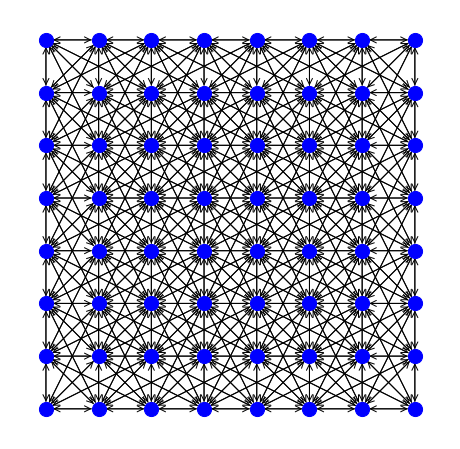| CompareOneToOne-function {SpatialKWD} | R Documentation |
Compare a pair of spatial histograms
Description
This function computes the Kantorovich-Wasserstein between a pair of spatial histograms defined over the same grid map.
The grid map is described by the two lists of N coordinates Xs and Ys, which specify the coordinates of the centroid of each tile of the map.
For each tile i with coordinates Xs[i], Ys[i], we have the two lists of weights, one for the first histograms and the other for the second histogram.
The two lists of coordinates are passed to compareOneToOne as a matrix with N rows and two columns.
The two lists of weights are passed as a matrix with N rows and two columns, a column for each histogram.
Usage
compareOneToOne(Coordinates, Weights, L = 3, recode = TRUE,
method = "approx", algorithm = "colgen",
model="mincostflow", verbosity = "silent",
timelimit = 14400, opt_tolerance = 1e-06,
unbalanced = FALSE, unbal_cost = 1e+09, convex = TRUE)
Arguments
Coordinates |
A
|
Weights |
A
|
L |
Approximation parameter. Higher values of L give a more accurate solution, but they require a longer running time. Data type: positive integer. |
recode |
If equal to |
method |
Method for computing the KW distances: |
algorithm |
Algorithm for computing the KW distances: |
model |
Model for building the underlying network: |
verbosity |
Level of verbosity of the log: |
timelimit |
Time limit in second for running the solver. |
opt_tolerance |
Numerical tolerance on the negative reduced cost for the optimal solution. |
unbalanced |
If equal to |
unbal_cost |
Cost for the arcs going from each point to the extra artificial bin. |
convex |
If equal to |
Details
The function compareOneToOne(Coordinates, Weights, ...) computes the distance between the two histograms specified by the weights given in the two columns of matrix Weights.
The support points (i.e., centroids of each tile of the map) are defined by the coordinates given in Xs and Ys in the two columns of matrix Coordinates.
The algorithm used to compute such distance depends on the parameters specified as optional arguments of the function.
The most important is the parameter L, which by default is equal to 3. The following table shows the worst-case approximation ratio as a function of the value assigned to L.
The table also reports the number of arcs in the network flow model as a function of the number of bins n contained in the convex hull of the support points of the histograms given in input with matrix Coordinates.
| L | 1 | 2 | 3 | 5 | 10 | 15 |
Worst-case error | 7.61% | 2.68% | 1.29% | 0.49% | 0.12% | 0.06% |
Number of arcs | O(8n) | O(16n) | O(32n) | O(80n) | O(256n) | O(576n) |
The following two figures show the network build on a grid with 8x8 nodes and using L=2 and L=3.


Value
Return an R List with the following named attributes:
distance: The value of the KW-distance between the two input histograms.status: Status of the solver used to compute the distances.runtime: Overall runtime in seconds to compute all the distances.iterations: Overall number of iterations of the Network Simplex algorithm.nodes: Number of nodes in the network model used to compute the distances.arcs: Number of arcs in the network model used to compute the distances.
See Also
See also compareOneToMany, compareAll, focusArea, Histogram2D, and Solver.
Examples
# Define a simple example
library(SpatialKWD)
# Random coordinates
N = 90
Xs <- as.integer(runif(N, 0, 31))
Ys <- as.integer(runif(N, 0, 31))
coordinates <- matrix(c(Xs, Ys), ncol=2, nrow=N)
# Random weights
test1 <- matrix(runif(2*N, 0, 1), ncol=2, nrow=N)
# Compute distance
print("Compare one-to-one with exact algorithm:")
d <- compareOneToOne(coordinates, Weights=test1, method="exact",
recode=TRUE, verbosity = "info")
cat("runtime:", d$runtime, " distance:", d$distance,
" nodes:", d$nodes, " arcs:", d$arcs, "\n")
print("Compare one-to-one with approximate algorithm:")
d <- compareOneToOne(coordinates, Weights=test1, L=2, recode=TRUE)
cat("L: 2, runtime:", d$runtime, " distance:", d$distance,
" nodes:", d$nodes, " arcs:", d$arcs, "\n")
d <- compareOneToOne(coordinates, Weights=test1, L=3)
cat("L: 3 runtime:", d$runtime, " distance:", d$distance, "\n")
d <- compareOneToOne(coordinates, Weights=test1, L=10)
cat("L: 10, runtime:", d$runtime, " distance:", d$distance, "\n")